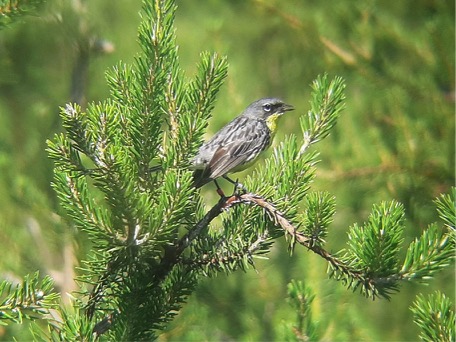By Kathleen Snyder
When we last visited with Dalton Spencer, BHAS Board member, he had finished up his freshman year at Montana State University in Bozeman and had spent the summer of 2020 surveying grassland birds in Montana, Nebraska and South Dakota. A year later, Dalton is heading into his junior year at Bozeman and spent this summer surveying Kirtland’s Warblers in Michigan.
Hired by the Smithsonian Conservation Biology Institute for their Kirtland’s Warbler project, Dalton drove to northern Michigan in late April. He and three other surveyors lived in an employer-provided house in Lovells Township (population 626). All of them conducted spot mapping surveys of adult male Kirtland’s. Surveying was done on Michigan Department of Natural Resources land (apparently all Michigan Kirtland’s nest on public land). There were 16 plots averaging a mile by a half mile in size and the crew rotated between them. Also occurring under the same program were nest surveys and point counts; combined there were 13 surveyors. The project ended July 15th.
According to the project’s website, Smithsonian scientists have been working to manage Kirtland’s Warblers since 2006. They are one of North America’s rarest and most range-restricted songbirds, breeding almost exclusively in northern Michigan and wintering primarily in the Bahamas. They only breed in young jack pine forests that are five to 20 years old. Decades of fire suppression prevented this new breeding habitat from forming. Additionally, parasitism by Brown-headed Cowbirds limited warblers’ reproductive success.
A combination of successful cowbird control efforts and the planting of new jack pine habitat has helped the Kirtland’s warbler population recover. Once listed as endangered, the warbler population has gone from 167 males in 1987 to more than 2300 males in 2015. Kirtland’s Warblers were removed from the endangered species list in 2019.
Dalton can echo this good news. Cowbird control is no longer happening or needed. The density of Kirtlands is good where appropriate jack pine forest exists. In 2 of his plots, he had over 100 male birds. Dalton appreciated how friendly and exuberant these songbirds are. He was out surveying six days a week, from sunrise to 11:30 am, walking through difficult terrain. In fact, the co-workers named the jack pines “Bad Jack” and two of the surveyors, including Dalton, damaged their binoculars interacting with “Bad Jack”.
There was snowfall in the middle of May (no accumulation), sub-freezing mornings at the beginning of the period, and temperatures over 90 degrees by the end. Fortunately, COVID-19 did not affect the research or Dalton’s exploration of Michigan. He was very happy to report finding 34 life birds and 242 total species in 10 weeks in 67 of the 85 Michigan counties.
Now back in Montana, Dalton has resumed his studies towards a degree in Wildlife Management. When his life isn’t too hectic, he attends BHAS Board meetings via video call and he plans to run the Lewis County Christmas Bird Count again in December. We look forward to seeing Dalton then.If you are thinking of visiting Michigan in search of Kirtland’s Warblers, be aware that access to their nesting grounds is restricted and best done with a guided tour. Visit this website for further information









